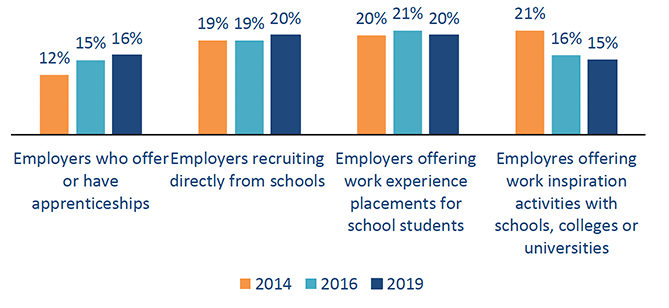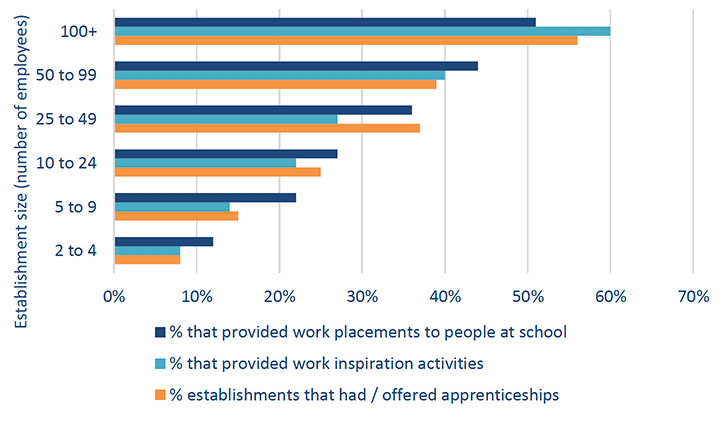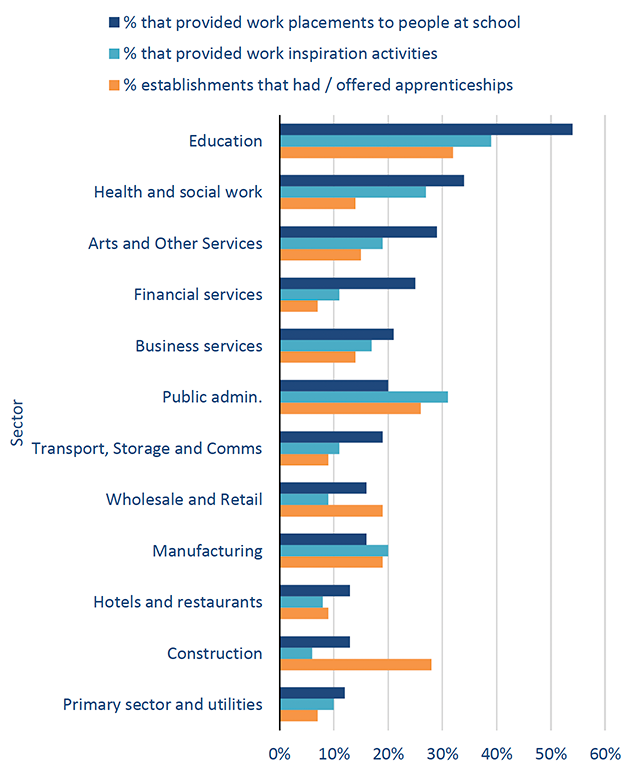Developing young workforce strategy - impact on employer engagement: evaluation
An independent evaluation of the impact of Developing the Young Workforce Strategy on employer engagement.
Appendix 2: Desk-based review of data and literature
Data sources
Details on the main sources of information drawn upon for this review are provided below.
- Scottish Employer Perspectives Survey (EPS) (Scottish Government, 2019).
The most recent data from the Scottish EPS is from the 2019 survey. Data is also available from 2014 and 2016. Results from the 2021 EPS were published in 2022, after the desk based review had been completed (Scottish Government, 2022). However, the findings of the most recent EPS are included in the DYW Evidence Syntheis published alongside this evaluation.
Therefore, data is only included on employer perspectives pre-pandemic. The 2019 survey included 2,652 employers in Scotland. The survey includes specific questions on the Scottish Government's Developing the Young Workforce (DYW) programme. Key findings from the 2019 survey, including comparisons with 2014 and 2016 surveys, are provided throughout the review.
- Scottish Employer Skills survey (Scottish Government, 2020).
The Scottish Employer Skills Survey (ESS) is a large-scale telephone survey. The most recent iteration of this survey surveyed 3,497 employers in Scotland between October and December 2020. Key findings from the ESS are provided in section 1.3
- Senior Phase: Headteacher Survey (Scottish Government, 2019).
Survey of headteachers of secondary schools in Scotland in June 2019. 45% of all headteachers in Scotland responded to the survey.
Pre-pandemic DYW employer engagement
The 2018 Rocket Science literature review on The Impact of Employer Engagement with Schools for DYW Glasgow found that different forms of engagement have different impacts in terms of pupil characteristics and combinations of employer activities. Young people across the UK found these activities most beneficial in gaining cultural capital (increased confidence and academic motivation). Benefits to employers included low recruitment costs and risk, building a network of local talent, increasing job motivation and satisfaction, and a positive impact on employees' skills development (Rocket Science, 2018).
The EPS provides findings on the proportions of employers across Scotland providing opportunities to young people, including provision of work placements, work inspiration activities (this includes activities such as career talks, mock interviews and site visits) and apprenticeships. An overview of this data from the 2014, 2016 and 2019 EPS is provided in Figure 2 overleaf.
The proportion of employers recruiting directly from schools and offering work experience placements remained relatively stable from 2014 – 2019. However there was a notable fall in the proportion offering work inspiration activities from 21% in 2014 to 15% in 2019, while the proportion offering or having apprenticeships rose. The EPS demonstrates an opportunity to expand the number of employers offering work placements and work inspiration activities.

There is notable (and predictable) variation in engagement between differently sized organisations, with larger organisations more likely to be offering work placements and work inspiration activities (Figure 2). The smallest employers were half as likely as those with five or more employees to provide work placements. 51% of employers with over 100 employees offered work placements to school pupils. Larger employers are also more likely to offer work inspiration activities, with 60% of employers with over 100 employees doing so.

There is also notable variation between sectors in the proportion offering work placements and activities to young people. The education sector was more likely than any others to offer work placements to school pupils; 54% of all employers in this sector did so in the 12 months to 2019. This was followed by Health and social work (34%) and arts and other services (29%). Employers in hotels and restaurants (13%) construction (13%) and primary sector and utilities (12%) were the lease likely to have offered work placements.
Education (39%) and public administration (31%) were the most likely to offer work inspiration activities, and construction (6%) and hotels and restaurants (8%) are least likely.

In terms of best practice for employer engagement, Rocket Science developed a strategic toolkit for DYW schools in 2019 with guidance on getting the best employer engagement for young people, which among other aspects looked at the role and timing of different employer engagement activities based on different types of organisations and sectors. The toolkit included a reference to the DYW guidance on Employer Partnerships in Education: support for evaluation and improvement that was developed in October 2018. This describes school-employer partnerships at three levels:
- Engagement, likely to involve a one‐off activity by an employer such as an interview session or a career activity.
- Collaboration, a longer‐term commitment between the employer and the school, such as regular contextualised learning or work experience.
- Influencing, a long‐term partnership where the employer has considerable influence on the curriculum offer of the schools through, for example, an employer contributing to lessons in the classroom (Rocket Science, 2019).
Findings from the most recent Senior Phase headteacher survey also show that, in 2019, 75% of surveyed schools had established long-term relationships with employers. These partnerships tended to be focused on opportunities for young people. 84% of Headteachers were seeking direct access to employment opportunities through their partnerships with employers. Headteachers felt that additional time and staff resources dedicated to building partnerships with employers would be helpful. The main factors underpinning successful collaboration between employers and headteachers were:
- Willingness of both partners.
- Recognition of mutual benefits of partnerships.
- Support from organisations such as the local authority and Skills Development Scotland.
Barriers to engagement
There is some evidence of barriers to engagement in the EPS, as well as further literature sources. In the EPS, employers were asked about the barriers to offering work placements. The most commonly mentioned were structural (mentioned by 28%) including not having suitable roles (38%) and not having time or resources (20%) (Internal Publication).
Further to this, the 2017 Education Scotland Review of the implementation of the Career Education Standard, Work Placement Standard and Guidance on School/Employer partnerships aimed to uncover if these standards and guidance were ambitious enough to deliver the aspirations of the DYW strategy. The report found that many employers were unaware of the available standards and guidance. It concluded that the Scottish Government should work with DYW Regional Groups and partners to support the use of standards and guidance in developing school-employer partnerships (Education Scotland, 2017).
The 2020 Education Scotland report on Inspection Findings: Developing the Young Workforce also gave further details on the impact of DYW on primary, secondary and special schools across the country. It found that most schools have introduced partnership-working with local employers. These partnerships are particularly effective for around half of secondary schools and bring benefit to young people, but, overall, employers are not yet sufficiently involved in curriculum design or evaluation (Education Scotland, 2020).
Gender inequalities and STEM careers
Supporting young people to get into STEM is crucial for the sustainability of future workforce, as jobs requiring STEM skills are expected to increase at twice the rate of other roles (Archer et al., 2014) and digital careers are expected to grow at 3.46% from 2021-2027 (Careersmart). However, there are currently wide disparities concerning representation in STEM in the UK. For example, despite comprising over 45% of the workforce, women only make up 13% of the STEM field (Careersmart).
Young girls and those from deprived backgrounds face several psychosocial barriers which limit their engagement with STEM. For example, research shows that students from deprived backgrounds may have less awareness about STEM and not have mentors that they identify with, leading young people to believe that they are not suitable for STEM careers (Duodu, et al., 2017). These differences in interest and representation in STEM are observable starting in early childhood, making it crucial for initiatives to increase participation from these groups (Emembolu et al., 2020). Research also shows that children form ideas and aspirations about their future careers from a very young age, demonstrating the need to illustrate opportunities in STEM from primary level (McMahon et al. 2010).
Evaluation of DYW regional groups
Through desk research, field work with employers and analysis, the 2018 Formative Evaluation of the DYW Regional Groups reviewed and analysed what worked well in the DYW Regional Groups of Ayrshire; Edinburgh, Midlothian and East Lothian; Inverness and Central Highland; and North East, and where challenges remain to the implementation of the DYW Regional Groups. DYW Regional Groups aim to fulfil a leadership and communication role in employer engagement, and have an individual set of KPIs in addition to the overarching KPIs for the DYW programme.
Although this evaluation occurred too early to provide a full picture of the impact made, the Regional Groups were so far doing well in creating a single point of contact for employers to engage with education and vice versa. Employers across the four reviewed Groups found the work of the Regional Groups valuable and that it had helped break down barriers for them to engage with schools through a simplified landscape and single point of contact.
The evaluation also found a positive impact on employers as a result of the Regional Groups' work, including offering more and / or better quality work experience placements and taking on more young people and apprentices (SQW, 2018).
The evaluation surveyed employers to uncover how the engagement was going and where the challenges remain:
- Employers tended to engage with DYW activities not because of benefits to their own company, but from a belief in giving back to the community and improving the work-readiness of young people.
- Employers engaged more often in stand-alone activities rather than recurring activities.
- Most employers (90%) undertook at least one activity organised through the Regional Group, most frequently focused on careers and/or skills fairs.
- Schools reported that, through DYW Regional Group engagement, employers had started to offer higher quality and/or more employment activities to students, resulting in a positive impact on students.
- Some employers faced barriers in aligning their activities with school / college timetables and releasing staff (SQW, 2018).
Findings from the EPS also confirm that establishments engaging with DYW Regional Groups are far more likely to be offering work experience or work inspiration activities to young people than those which are not engaging.
3% of employers who responded to the 2019 survey engaged with their DYW Regional Group over the last 12 months while 14% of employers were aware of a DYW Regional Group (this was an increase on the 2014 and 2016 surveys). This means that around a fifth of employers who were aware of a DYW Regional Group engaged with their group. The survey also showed that larger employers are more likely to be aware of and to have engaged with a DYW Regional Group.
72% of employers who had engaged with their local DYW Regional Group had offered work inspiration activities (compared to 15% of all employers). Employers that engaged with DYW regional groups were also more likely to have offered work placements – 84% of those who had engaged with the groups had offered work placements (compared to 36% of all employers). Building on findings from the formative evaluation of DYW regional groups described above, we therefore know that engagement with regional groups correlates both with increased provision of work-related activities for young people and with provision of better quality work-related activities.
Post-pandemic DYW employer engagement
There are few available resources documenting findings on DYW employer engagement since March 2020. While the Scottish Employer Skills Survey does not ask any questions directly related to DYW employer engagement approaches, the most recent results provide context on the on the skills challenges faced by employers in Scotland, including early findings on the impact of the COVID-19 pandemic as the survey took place between October and December 2020. Due to the timing of the survey, findings are affected by the COVID-19 pandemic.
Key findings from the survey relevant to this work include:
- A fifth (22%) of employers said the COVID-19 pandemic had affected their training plans, most commonly because planned courses were suspended or otherwise not available.
- Nearly 65% of employers had furloughed at least one member of staff in response to the pandemic. 12% of employers had made staff redundant or were in the process of doing so.
- There were regional differences in the impact of the COVID-19 pandemic on employers. For example, use of Coronavirus Job Retention Scheme (furlough) was highest in the West Region (72%) and lowest in Dumfries and Galloway (55%).
- Nearly all (96%) employers surveyed had changed their working practices in some way in response to the pandemic. The most common examples of these were an increase in staff working from home and changes to make workplaces 'COVID secure'. 35% of employers had more staff working from home. Increase in home working was most common in public administration (86%) and financial services (70%).
These early findings illustrate some of the additional pressures employers have experienced as a result of the COVID-19 pandemic. Many of these additional pressures and changes in working patterns are likely to have had an impact on the engagement of employers with DYW, for example, by affecting the time or resource available for engagement, and the practicalities of engagement such as bringing young people into the workplace.
The 2021 Rocket Science report Impact on Virtual Engagement on Young People for Developing the Young Workforce demonstrated that online engagement can encourage more employers to volunteer their time, and that online engagement particularly benefits employers and young people living in rural and remote areas who could otherwise not access opportunities. Virtual delivery had increased the accessibility of world of work experiences that certain groups might previously have been excluded from, because of their location or backgrounds. In addition, reaching disabled young people or those who have additional support needs (ASN) was a benefit of virtual delivery. However, most young people preferred face-to-face engagement and believed online support cannot substitute for "hands on" experience of the world of work. The report found that both stakeholders and young people agree that virtual experiences should always add value compared to what could be done in person, enhancing the offer around the world of work.
In terms of views of stakeholders, the report found that:
- To increase engagement and ensure a positive learning experience, experiences should be interactive and engaging for young people. Getting the balance right between time spent online and independent learning is important.
- Most stakeholders felt that the move to online / virtual delivery had broken down geographic barriers and had expanded (and increased) their reach.
- Stakeholders identified both positive and negative aspects of the virtual world of work for young people who are disadvantaged.
- Face-to-face, in person engagement is still seen as an important aspect for young people and should be retained.
- The exposure to virtual and remote ways of working was an important experience for young people.
- The way in which the session, course or work experience is structured was a large determinant of how positive the experience is for young people.
- The level of engagement and impact of virtual work experiences for young people was also dependent on the school (and the individual) in terms of their ability to engage and access to devices. Stakeholders are all in agreement that virtual work experiences are here to stay, and a model of blended / hybrid delivery should be adopted (Internal Rocket Science Publication, 2021).
Contact
Email: socialresearch@gov.scot
There is a problem
Thanks for your feedback